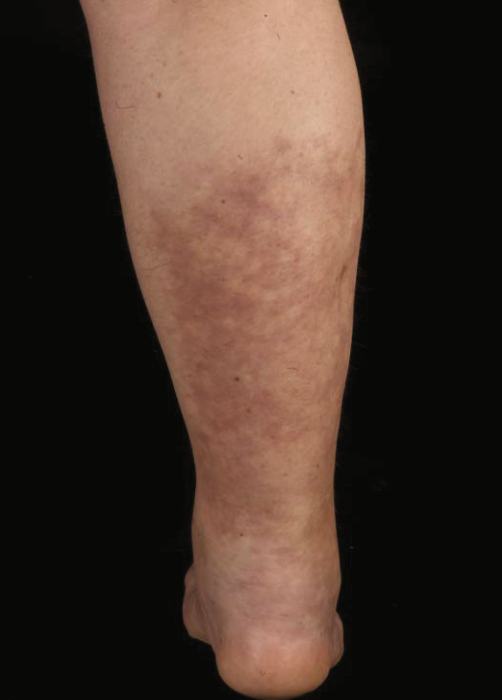WBR0656
| Author | [[PageAuthor::Ayokunle Olubaniyi, M.B,B.S [1] (Reviewed by Serge Korjian)]] |
|---|---|
| Exam Type | ExamType::USMLE Step 1 |
| Main Category | MainCategory::Pathology |
| Sub Category | SubCategory::Musculoskeletal/Rheumatology |
| Prompt | [[Prompt::A 34-year-old man is brought to the emergency department with acute onset of fever, malaise, abdominal pain, and bloody stools. His family reports that he has not been well and has lost at least 5 kg (11 lbs) in the past 3 weeks. On physical examination, you notice lower extremity edema with an overlying lace like skin rash (shown below). Further questioning reveals that patient was recently diagnosed with hepatitis C. Work-up shows reduced levels of serum complement and a positive cryglobulin test. Skin biopsy of the rash demonstrates small and medium vessel vasculitis. What is the most likely diagnosis in this patient? |
| Answer A | AnswerA::Giant cell arteritis |
| Answer A Explanation | [[AnswerAExp::Temporal arteritis, also known as Giant cell arteritis, is an inflammatory disease of blood vessels most commonly involving large and medium arteries of the head, predominantly the branches of the external carotid artery. It is a form of vasculitis. The important features include jaw pain, ocular disturbances and an elevated ESR. The disease is often associated with polymyalgia rheumatica (majority of cases), systemic lupus erythematosus, rheumatoid arthritis, and severe infections. Diagnosis is by biopsy of the temporal artery. Corticosteroids, typically high-dose prednisone (1 mg/kg/day), must be started as soon as the diagnosis is suspected (even before the diagnosis is confirmed by biopsy) to prevent irreversible blindness secondary to ophthalmic artery occlusion.]] |
| Answer B | AnswerB::Thromboangiitis obliterans |
| Answer B Explanation | [[AnswerBExp::Thromboangiitis obliterans or Buerger’s disease is a recurring progressive inflammation and thrombosis (clotting) of small and medium arteries and veins of the hands and feet. It is strongly associated with use of tobacco products, primarily from smoking, but also from smokeless tobacco. Symptoms include intermittent claudication and Raynaud’s phenomenon. The majority of patients are men who are heavy smokers and show hypersensitivity to tobacco injected into the skin.]] |
| Answer C | AnswerC::Kawasaki syndrome |
| Answer C Explanation | [[AnswerCExp::Kawasaki disease is an autoimmune disease in which the medium-sized blood vessels throughout the body become inflamed. It is largely seen in children under five years of age. It affects many organ systems, mainly those including the blood vessels, skin, mucous membranes, and lymph nodes. The most serious effect is on the heart where it can cause fatal coronary artery aneurysms in untreated children. It is characterized by conjunctival and oral erythema (red-strawberry tongue), fever, erythema and edema of the palms and soles, generalized rash, and cervical lymph node swelling.]] |
| Answer D | AnswerD::Polyarteritis nodosa |
| Answer D Explanation | [[AnswerDExp::Polyarteritis nodosa, a.k.a Kussmaul disease or Panarteritis nodosa, is a form of vasculitis (i.e., inflammation of a blood vessel) affecting mainly the small and medium-sized arteries, particularly the renal, cardiac, and gastrointestinal tract vessels. Majority of patients (30%) have a positive hepatitis B infection, but hepatitis C-induced PAN has also been reported.]] |
| Answer E | AnswerE::Takayasu’s arteritis |
| Answer E Explanation | [[AnswerEExp::Takayasu’s arteritis also known as aortic arch syndrome, nonspecific aortoarteritis and the pulseless disease, is a form of large vessel granulomatous vasculitis with massive intimal fibrosis and vascular narrowing, affecting often young or middle-aged women of Asian descent. It mainly affects the aorta and its branches, as well as the pulmonary arteries. Clinically, patients often have lower blood pressure and weaker pulses in the upper extremities than in the lower extremities; some patients have ocular disturbances as well.]] |
| Right Answer | RightAnswer::D |
| Explanation | [[Explanation::This patient has signs and symptoms of vasculitis in combination with a positive hepatitis C antibody. This is highly suggestive of polyarteritis nodosa (PAN).
Polyarteritis nodosa, a.k.a Kussmaul disease or Panarteritis nodosa, is a form of vasculitis (i.e., inflammation of a blood vessel) affecting mainly the small and medium-sized arteries, particularly the renal, cardiac, and gastrointestinal tract vessels. Majority of patients (30%) have a positive hepatitis B infection, but hepatitis C-induced PAN has also been reported. Hepatitis C virus infection can be associated with a fulminant form of vasculitis in the form of polyarteritis nodosa. This may be easily confused mixed with cryoglobulinemia, which is also associated with hepatitis C virus. Signs and symptoms include: fever, fatigue, weakness, loss of appetite, weight loss, muscle and joint aches. The skin may show rashes, swelling, ulcers, and lumps. Palpable purpura and livedo reticularis can occur in some patients. Nerve involvement may cause sensory changes with numbness, pain, burning, and weakness (peripheral neuropathy). Central nervous system involvement may cause strokes or seizures. Kidney involvement can produce varying degrees of renal failure, such as hypertension, edema, oliguria and uremia. Involvement of the arteries of the heart may cause a heart attack, heart failure, and inflammation of the sac around the heart (pericarditis). Diagnosis is generally based on the physical examination and a few laboratory studies that help confirm the diagnosis – CBC, ESR, C-reactive protein and p-ANCA. Treatment involves the use of immunosuppressants – prednisone, cyclophosphamide and methotrexate. |
| Approved | Approved::No |
| Keyword | WBRKeyword::Polyarteritis nodosa, WBRKeyword::Takayasu’s arteritis, WBRKeyword::Kawasaki disease, WBRKeyword::Thromboangiitis obliterans, WBRKeyword::Temporal arteritis |
| Linked Question | Linked:: |
| Order in Linked Questions | LinkedOrder:: |
